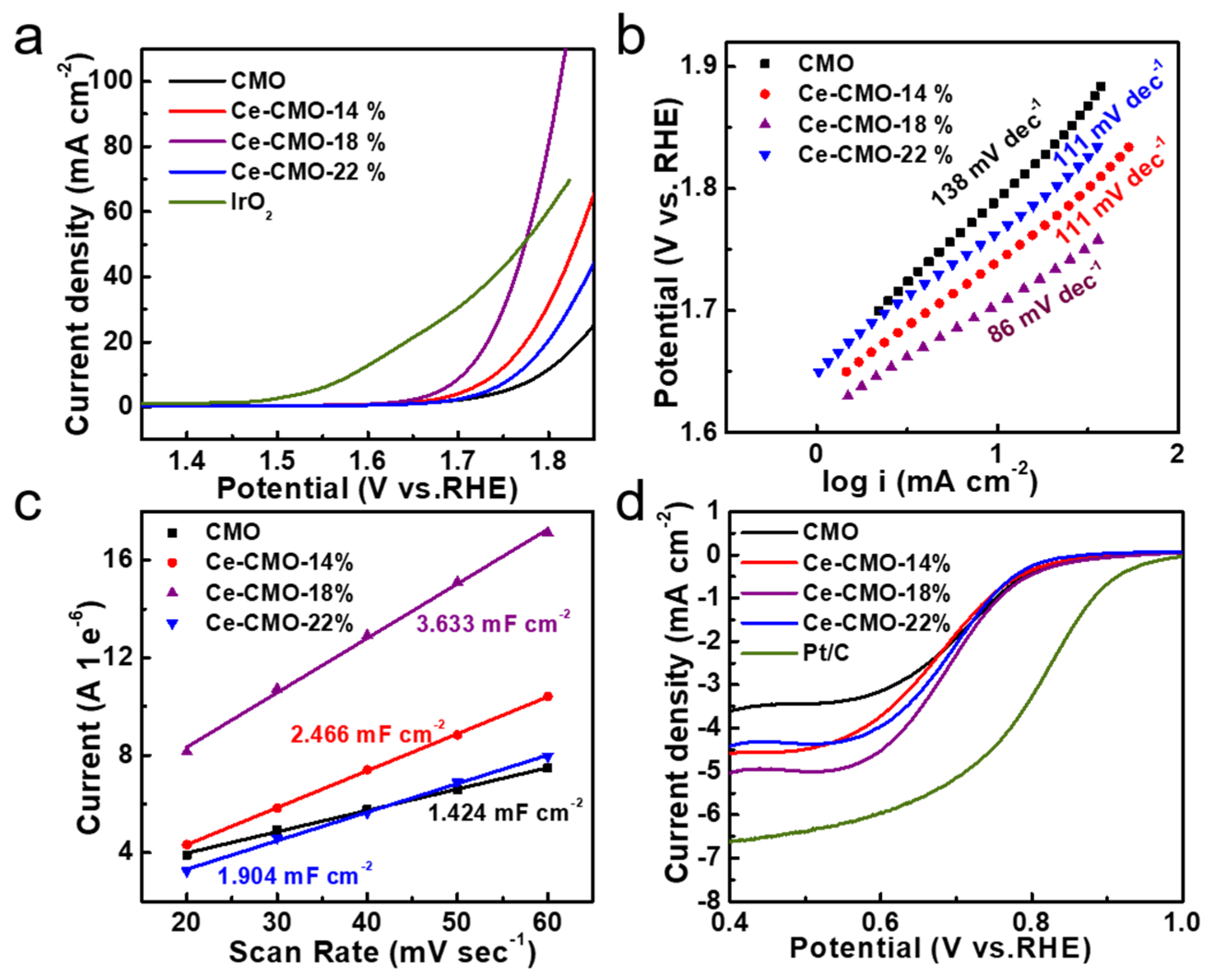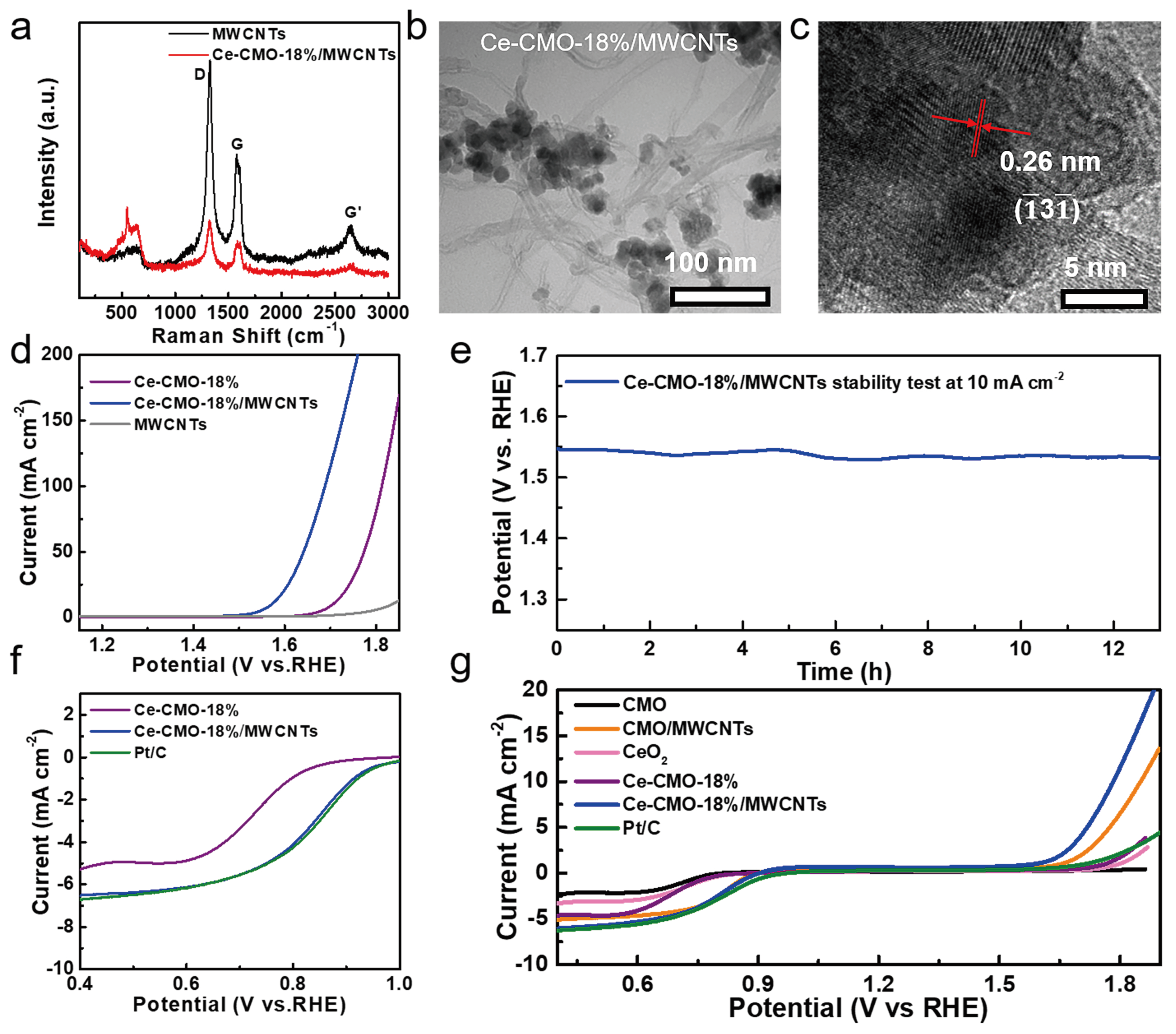Cerium-Doped CoMn2O4 Spinels as Highly Efficient Bifunctional Electrocatalysts for ORR/OER Reactions
Abstract
:1. Introduction
2. Results and Discussion
2.1. Synthesis and Characterizations of CoMn2O4 (CMO) and Ce-CMO-X Electrocatalysts
2.2. The Electronic Structure of CMO Spinels after Ce Doping
2.3. OER and ORR Performance of CMO and Ce-CMO Electrocatalysts
2.4. Bifunctional OER and ORR Catalytic Performance of Ce-CMO-18%/MWCNTs
3. Materials and Methods
3.1. Materials
3.2. Experimental Section
3.2.1. Synthesis of CMO and Ce-CMO-X Nanoparticles
3.2.2. Synthesis of Ce-CMO-18%/MWCNTs Composites
3.3. Characterization
3.4. Electrochemical Measurements
4. Conclusions
Supplementary Materials
Author Contributions
Funding
Data Availability Statement
Acknowledgments
Conflicts of Interest
References
- Chu, S.; Cui, Y.; Liu, N. The path towards sustainable energy. Nat. Mater. 2017, 16, 16–22. [Google Scholar] [CrossRef]
- Stamenkovic, V.R.; Strmcnik, D.; Lopes, P.P.; Markovic, N.M. Energy and fuels from electrochemical interfaces. Nat. Mater. 2017, 16, 57–69. [Google Scholar] [CrossRef]
- Ding, H.; Liu, H.F.; Chu, W.S.; Wu, C.Z.; Xie, Y. Structural transformation of heterogeneous materials for electrocatalytic oxygen evolution reaction. Chem. Rev. 2021, 121, 13174–13212. [Google Scholar] [CrossRef]
- Wang, Y.; Li, J.; Wei, Z.D. Transition-metal-oxide-based catalysts for the oxygen reduction reaction. J. Mater. Chem. A 2018, 6, 8194–8209. [Google Scholar] [CrossRef]
- Zhang, J.T.; Zhao, Z.H.; Xia, Z.H.; Dai, L.M. A metal-free bifunctional electrocatalyst for oxygen reduction and oxygen evolution reactions. Nat. Nanotechnol. 2015, 10, 444–452. [Google Scholar] [CrossRef]
- Cook, T.R.; Dogutan, D.K.; Reece, S.Y.; Surendranath, Y.; Teets, T.S.; Nocera, D.G. Solar energy supply and storage for the legacy and nonlegacy worlds. Chem. Rev. 2010, 110, 6474–6502. [Google Scholar] [CrossRef]
- Nie, Y.; Li, L.; Wei, Z.D. Recent advancements in Pt and Pt-free catalysts for oxygen reduction reaction. Chem. Soc. Rev. 2015, 44, 2168–2201. [Google Scholar] [CrossRef]
- Reier, T.; Oezaslan, M.; Strasser, P. Electrocatalytic oxygen evolution reaction (OER) on Ru, Ir, and Pt catalysts: A comparative study of nanoparticles and bulk materials. ACS Catal. 2012, 2, 1765–1772. [Google Scholar] [CrossRef]
- Wang, W.; Liu, E.S.; Hu, Y.C.; Jiao, L.; Kolla, P.; Liu, Y.C.; Tang, M.H.; Luo, J.; Sun, Q.; Chen, S.L.; et al. Understanding the ORR electrocatalysis on Co–Mn oxides. J. Phys. Chem. C 2021, 125, 25470–25477. [Google Scholar] [CrossRef]
- Xu, Y.J.; Sumboja, A.; Zong, Y.; Darr, J.A. Bifunctionally active nanosized spinel cobalt nickel sulfides for sustainable secondary zinc–air batteries: Examining the effects of compositional tuning on OER and ORR activity. Catal. Sci. Technol. 2020, 10, 2173–2182. [Google Scholar] [CrossRef]
- Ji, D.W.; Liu, C.H.; Yao, Y.H.; Luo, L.L.; Wang, W.C.; Chen, Z.D. Cerium substitution in LaCoO3 perovskite oxide as bifunctional electrocatalysts for hydrogen and oxygen evolution reactions. Nanoscale 2021, 13, 9952–9959. [Google Scholar] [CrossRef]
- Gu, X.-K.; Samira, S.; Nikolla, E. Oxygen sponges for electrocatalysis: Oxygen reduction/evolution on nonstoichiometric, mixed metal oxides. Chem. Mater. 2018, 30, 2860–2872. [Google Scholar] [CrossRef]
- Patra, S.; Choudhary, R.; Roy, E.; Madhuri, R.; Sharma, P.K. Heteroatom-doped graphene ‘Idli’: A green and foody approach towards development of metal free bifunctional catalyst for rechargeable zinc-air battery. Nano Energy 2016, 30, 118–129. [Google Scholar] [CrossRef]
- Zhao, Q.; Yan, Z.H.; Chen, C.C.; Chen, J. Spinels: Controlled preparation, oxygen reduction/evolution reaction application, and beyond. Chem. Rev. 2017, 117, 10121–10211. [Google Scholar] [CrossRef]
- Li, C.; Han, X.P.; Cheng, F.Y.; Hu, Y.X.; Chen, C.C.; Chen, J. Phase and composition controllable synthesis of cobalt manganese spinel nanoparticles towards efficient oxygen electrocatalysis. Nat. Commun. 2015, 6, 1–8. [Google Scholar] [CrossRef]
- Devaguptapu, S.V.; Hwang, S.; Karakalos, S.; Zhao, S.; Gupta, S.; Su, D.; Xu, H.; Wu, G. Morphology control of carbon-free spinel NiCo2O4 catalysts for enhanced bifunctional oxygen reduction and evolution in alkaline media. ACS Appl. Mater. Interfaces 2017, 9, 44567–44578. [Google Scholar] [CrossRef]
- Liu, W.J.; Bao, J.; Xu, L.; Guan, M.L.; Wang, Z.L.; Qiu, J.X.; Huang, Y.P.; Xia, J.X.; Lei, Y.C.; Li, H.M. NiCo2O4 ultrathin nanosheets with oxygen vacancies as bifunctional electrocatalysts for Zn-air battery. Appl. Surf. Sci. 2019, 478, 552–559. [Google Scholar] [CrossRef]
- Hirai, S.; Yagi, S.; Seno, A.; Fujioka, M.; Ohno, T.; Matsuda, T. Enhancement of the oxygen evolution reaction in Mn3+-based electrocatalysts: Correlation between Jahn–Teller distortion and catalytic activity. RSC Adv. 2016, 6, 2019–2023. [Google Scholar] [CrossRef]
- Xu, Y.J.; Sumboja, A.; Groves, A.; Ashton, T.; Zong, Y.; Darr, J.A. Enhancing bifunctional catalytic activity of cobalt–nickel sulfide spinel nanocatalysts through transition metal doping and its application in secondary zinc-air batteries. RSC Adv. 2020, 10, 41871–41882. [Google Scholar] [CrossRef]
- An, L.; Huang, L.; Zhou, P.P.; Yin, J.; Liu, H.Y.; Xi, P.X. A self-standing high-performance hydrogen evolution electrode with nanostructured NiCo2O4/CuS heterostructures. Adv. Funct. Mater. 2015, 25, 6814–6822. [Google Scholar] [CrossRef]
- Wang, L.M.; Liu, Q.F.; Ta, N.; Fan, H.F.; Wang, E.D. Multi-functional cerium modification to accelerate the oxygen reduction reaction of spinel Co3O4. ChemistrySelect 2021, 6, 3512–3518. [Google Scholar] [CrossRef]
- Wang, X.-T.; Ouyang, T.; Wang, L.; Zhong, J.-H.; Liu, Z.-Q. Surface reorganization on electrochemically-induced Zn–Ni–Co spinel oxides for enhanced oxygen electrocatalysis. Angew. Chem. Int. Ed. 2020, 132, 6554–6561. [Google Scholar] [CrossRef]
- Chutia, B.; Hussain, N.; Puzari, P.; Jampaiah, D.; Bhargava, S.K.; Matus, E.V.; Ismagilov, I.Z.; Kerzhentsev, M.; Bharali, P. Unraveling the role of CeO2 in stabilization of multivalent Mn species on α-MnO2/Mn3O4/CeO2/C surface for enhanced electrocatalysis. Energy Fuels 2021, 35, 10756–10769. [Google Scholar] [CrossRef]
- Li, J.B.; Shu, C.Z.; Hu, A.J.; Ran, Z.Q.; Li, M.L.; Zheng, R.X.; Long, J.P. Tuning oxygen non-stoichiometric surface via defect engineering to promote the catalysis activity of Co3O4 in Li-O2 batteries. Chem. Eng. J. 2020, 381, 122678. [Google Scholar] [CrossRef]
- Liu, Y.; Ma, C.; Zhang, Q.H.; Wang, W.; Pan, P.F.; Gu, L.; Xu, D.D.; Bao, J.C.; Dai, Z.H. 2D electron gas and oxygen vacancy induced high oxygen evolution performances for advanced Co3O4/CeO2 nanohybrids. Adv. Mater. 2019, 31, 1900062. [Google Scholar] [CrossRef]
- Xu, H.J.; Wang, B.K.; Shan, C.F.; Xi, P.X.; Liu, W.S.; Tang, Y. Ce-doped NiFe-layered double hydroxide ultrathin nanosheets/nanocarbon hierarchical nanocomposite as an efficient oxygen evolution catalyst. ACS Appl. Mater. Interfaces 2018, 10, 6336–6345. [Google Scholar] [CrossRef]
- Liu, K.; Huang, X.B.; Wang, H.Y.; Li, F.Z.; Tang, Y.G.; Li, J.S.; Shao, M.H. Co3O4–CeO2/C as a highly active electrocatalyst for oxygen reduction reaction in Al-air batteries. ACS Appl. Mater. Interfaces 2016, 8, 34422–34430. [Google Scholar] [CrossRef]
- Lee, J.; Ryou, Y.S.; Chan, X.J.; Kim, T.J.; Kim, D.H. How Pt interacts with CeO2 under the reducing and oxidizing environments at elevated temperature: The origin of improved thermal stability of Pt/CeO2 compared to CeO2. J. Phys. Chem. C 2016, 120, 25870–25879. [Google Scholar] [CrossRef]
- Iliev, M.N.; Padhan, P.; Gupta, A. Temperature-dependent Raman study of multiferroic Bi2NiMnO6 thin films. Phys. Rev. B 2008, 77, 172303. [Google Scholar] [CrossRef]
- Hu, Z.X.; Zhou, X.X.; Lu, Y.; Jv, R.M.; Liu, Y.; Li, N.; Chen, S.W. CoMn2O4 doped reduced graphene oxide as an effective cathodic electrocatalyst for ORR in microbial fuel cells. Electrochim. Acta 2019, 296, 214–223. [Google Scholar] [CrossRef]
- Xu, J.; Gao, P.; Zhao, T. Non-precious Co3O4 nano-rod electrocatalyst for oxygen reduction reaction in anion-exchange membrane fuel cells. Energy Environ. Sci. 2012, 5, 5333–5339. [Google Scholar] [CrossRef]
- Dong, C.; Qu, Z.P.; Qin, Y.; Fu, Q.; Sun, H.C.; Duan, X.X. Revealing the highly catalytic performance of spinel CoMn2O4 for toluene oxidation: Involvement and replenishment of oxygen species using in situ designed-TP techniques. ACS Catal. 2019, 9, 6698–6710. [Google Scholar] [CrossRef]
- Liu, B.; Li, C.M.; Zhang, G.Q.; Yao, X.S.; Chuang, S.S.C.; Li, Z. Oxygen vacancy promoting dimethyl carbonate synthesis from CO2 and methanol over Zr-doped CeO2 nanorods. ACS Catal. 2018, 8, 10446–10456. [Google Scholar] [CrossRef]
- Zhang, S.; Xia, Z.M.; Zou, Y.; Cao, F.X.; Liu, Y.X.; Ma, Y.Y.; Qu, Y.Q. Interfacial frustrated Lewis pairs of CeO2 activate CO2 for selective tandem transformation of olefins and CO2 into cyclic carbonates. J. Am. Chem. Soc. 2019, 141, 11353–11357. [Google Scholar] [CrossRef] [PubMed]
- Qiu, C.; Qian, K.; Yu, J.; Sun, M.Z.; Cao, S.F.; Gao, J.Q.; Yu, R.X.; Fang, L.Z.; Yao, Y.W.; Lu, X.Q.; et al. MOF-transformed In2O3-x@C nanocorn electrocatalyst for efficient CO2 reduction to HCOOH. Nano-Micro Lett. 2022, 14, 167. [Google Scholar] [CrossRef] [PubMed]
- Ma, T.; Li, C.; Chen, X.; Cheng, F.Y.; Chen, J. Spinel cobalt–manganese oxide supported on non-oxidized carbon nanotubes as a highly efficient oxygen reduction/evolution electrocatalyst. Inorg. Chem. Front. 2017, 4, 1628–1633. [Google Scholar]
- Chen, J.J.; Zhou, N.; Wang, H.Y.; Peng, Z.G.; Li, H.Y.; Tang, Y.G.; Liu, K. Synergistically enhanced oxygen reduction activity of MnOx−CeO2/ketjenblack composites. Chem. Commun. 2015, 51, 10123–10126. [Google Scholar] [CrossRef]
- Su, H.; Wang, X.T.; Hu, J.X.; Ouyang, T.; Xiao, K.; Liu, Z.Q. Co-Mn spinel supported self-catalysis induced N-doped carbon nanotubes with high efficiency electron transport channels for zinc-air batteries. J. Mater. Chem. A 2019, 7, 22307–22313. [Google Scholar] [CrossRef]
- Han, X.P.; Wu, X.Y.; Zhong, C.; Deng, Y.D.; Zhao, N.Q.; Hu, W.B. NiCo2S4 nanocrystals anchored on nitrogen-doped carbon nanotubes as a highly efficient bifunctional electrocatalyst for rechargeable zinc-air batteries. Nano Energy 2017, 31, 541–550. [Google Scholar] [CrossRef]
- Gou, W.Y.; Zhang, M.K.; Zou, Y.; Zhou, X.M.; Qu, Y.Q. Iridium-chromium oxide nanowires as highly performed OER catalysts in acidic media. ChemCatChem 2019, 11, 6008–6014. [Google Scholar] [CrossRef]
- Chang, K.; Tran, D.T.; Wang, J.Q.; Kim, N.H.; Lee, J.H. A 3D hierarchical network derived from 2D Fe-doped NiSe nanosheets/carbon nanotubes with enhanced OER performance for overall water splitting. J. Mater. Chem. A 2022, 10, 3102–3111. [Google Scholar] [CrossRef]
- Singh, T.I.; Maibam, A.; Cha, D.C.; Yoo, S.; Babarao, R.; Lee, S.U.; Lee, S. High-alkaline water-splitting activity of mesoporous 3D heterostructures: An amorphous-shell@crystalline-core nano-assembly of Co-Ni-Phosphate ultrathin-nanosheets and V- doped Cobalt-Nitride nanowires. Adv. Sci. 2022, 9, 2201311. [Google Scholar] [CrossRef] [PubMed]




| Sample | Co 2p (Co3+/Co2+) | O 1s (OV/OL) | Ce 3d (Ce3+/Ce4+) | Mn 2p (Mn4+/Mn3+) |
|---|---|---|---|---|
| CMO | 0.67 | 0.62 | - | 0.39 |
| Ce-CMO-14% | 0.72 | 0.75 | 0.41 | 0.49 |
| Ce-CMO-18% | 0.96 | 0.85 | 0.56 | 0.54 |
| Ce-CMO-22% | 0.70 | 0.70 | 0.34 | 0.42 |
| Ce-CMO-18%/MWCNTs | 1.01 | 1.10 | 0.45 | 0.53 |
| Sample | OER | ORR | |||
|---|---|---|---|---|---|
| ηonset (mV) | η (mV) @ 10 mA cm−2 | Tafel slope (mV dec−1) | JL (mA cm−2) | E (mV) @ 3 mA cm−2 | |
| CMO | 414 | 562 | 138 | 3.4 | 617 |
| Ce-CMO-14% | 398 | 511 | 111 | 4.5 | 643 |
| Ce-CMO-18% | 378 | 476 | 86 | 5.0 | 675 |
| Ce-CMO-22% | 419 | 534 | 111 | 4.4 | 660 |
Publisher’s Note: MDPI stays neutral with regard to jurisdictional claims in published maps and institutional affiliations. |
© 2022 by the authors. Licensee MDPI, Basel, Switzerland. This article is an open access article distributed under the terms and conditions of the Creative Commons Attribution (CC BY) license (https://creativecommons.org/licenses/by/4.0/).
Share and Cite
Chen, X.; Han, F.; Chen, X.; Zhang, C.; Gou, W. Cerium-Doped CoMn2O4 Spinels as Highly Efficient Bifunctional Electrocatalysts for ORR/OER Reactions. Catalysts 2022, 12, 1122. https://doi.org/10.3390/catal12101122
Chen X, Han F, Chen X, Zhang C, Gou W. Cerium-Doped CoMn2O4 Spinels as Highly Efficient Bifunctional Electrocatalysts for ORR/OER Reactions. Catalysts. 2022; 12(10):1122. https://doi.org/10.3390/catal12101122
Chicago/Turabian StyleChen, Xiao, Fengshuang Han, Xi Chen, Chenxi Zhang, and Wangyan Gou. 2022. "Cerium-Doped CoMn2O4 Spinels as Highly Efficient Bifunctional Electrocatalysts for ORR/OER Reactions" Catalysts 12, no. 10: 1122. https://doi.org/10.3390/catal12101122
APA StyleChen, X., Han, F., Chen, X., Zhang, C., & Gou, W. (2022). Cerium-Doped CoMn2O4 Spinels as Highly Efficient Bifunctional Electrocatalysts for ORR/OER Reactions. Catalysts, 12(10), 1122. https://doi.org/10.3390/catal12101122






